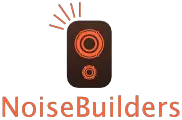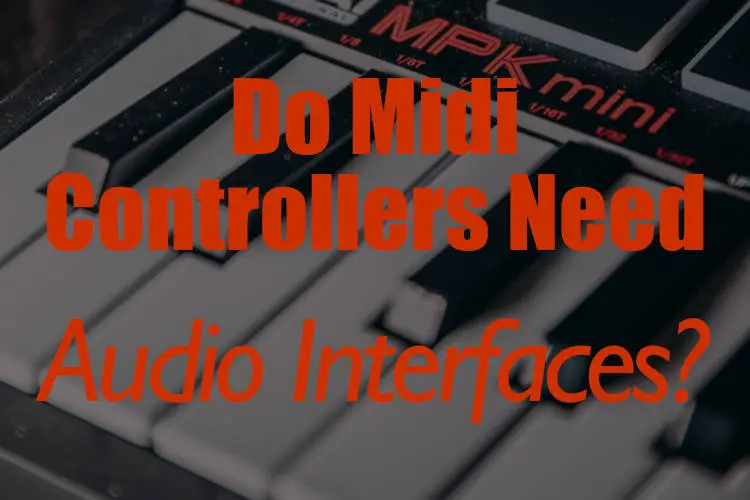MIDI controllers are one of the best pieces of audio equipment that you can use in order to create and manipulate “digital” music. However, many individuals don’t know how they work, how to connect them up to their recording device (computer, laptop, or Mac), or what other audio equipment they need, like an interface.
MIDI keyboards (controllers) that come with a USB connection point will not need an audio interface. They will connect directly to your recording device via USB. MIDI controllers with MIDI IN/OUT connection points will need an audio interface that supports MIDI IN/OUT connection points for them to connect to a recording device.
If you have a MIDI controller and are wondering if you need an audio interface to connect it up to your recording device, this article will significantly benefit you. We will detail the different types of MIDI controllers and the connection points used to connect them to an interface and your recording device.
Do MIDI controllers need an audio interface?
In most cases, a MIDI controller will not need an audio interface because MIDI controllers nowadays are connected up via USB. However, this will only be the case if the MIDI controller has a USB connection point to which you can connect up to your recording device (computer, laptop, Mac).
The only instances where a MIDI controller will need an audio interface is if the controller does not have a USB connection and only has MIDI ports.
Furthermore, the audio interface along with your controller will need to have MIDI connection points, both IN and OUT connection points, to connect to each other.
Suppose both your MIDI controller has no USB connection point and your audio interface does not have MIDI connection points. In that case, you will need to look at purchasing one of these items that have one of these features for compatibility.
Lastly, you get different types of MIDI controllers that can also double as a digital piano. In these instances, the digital piano may have a line-out connection point which means you are able to send the audio out from the digital piano to the audio interface via a jack input which will typically be either a TS or TRS connection.
It will help if you remember that a MIDI controller typically does not have any stored sound samples or banks, and as such, you will be using sounds from your DAW or plugins to generate sound. Hence, keyboards that are only MIDI controllers will not have a line-out because they technically don’t produce audio, only digital signals.
However, digital pianos do have stored samples and sounds that create actual audio, and in this case, that audio is able to run across a standard audio cable such as a jack (TS or TRS) cable.
Understanding MIDI
In order to determine whether or not audio interfaces can utilize MIDI from a controller, we need to understand a little bit more about it.
MIDI stands for Musical Instrument Digital Interface. It describes a universal digital communication protocol that transmits a digital signal between instruments or other pieces of audio equipment.
It will help if you understand that MIDI does not send audio. Rather, the data it sends contains information such as note pitch, note velocity, aftertouch, and controller movements (knobs, wheels, and buttons).
We said that MIDI does not transmit any type of audio signal but rather data, and therefore, the cables are designed differently to USB cables and standard audio cables such as a jack cable (both TS and TRS) and balanced XLR cables.
A standard MIDI cable will look similar to an XLR cable, but it will have five pins that make up the connection point.
How to connect a MIDI keyboard to an audio interface
We will assume that you have a MIDI controller and audio interface has MIDI ports (both IN and OUT ports) for this tutorial.
The process is pretty straightforward for connecting up your MIDI controller to your audio interface. However, it may be a bit confusing because the cabling will run from one port to the opposite one, ie, you will run a midi cable from the output of your controller to the input of the audio interface and vice versa.
Due to the fact that MIDI is a digital form of data that gets sent, it both needs to send and receive data from the audio interface and the controller. This is the reason why you need to have two MIDI cables connected to the IN and OUT ports on both your controller and audio interface. In essence, the two MIDI cables provide a loop for which the data can travel over.
The next thing you will need to do is turn on your controller, your audio interface, and your recording device (computer, laptop, or Mac). In your DAW, you will need to go to settings or preferences and enable and set up your MIDI controller from there.
Once that is done, hitting a note on the controller or playing with one of the buttons, knobs, or wheels will produce sound or change specific variables in your DAW.
Remember that your controller won’t have speakers or a headphone jack because it is not designed to produce sound. Hence, remember to have your monitors connected up to your audio interface or make sure you are listneing to your headphones connected to your audio interface.
Otherwise, everything may be set up correctly (including your DAW and plugins), but you will not hear any sound.
Check out this MIDI controller with MIDI connection points on Amazon here
Check out this audio interface with MIDI connection points on Amazon here
What if my MIDI controller does not have MIDI connection points?
As we stated, it is not uncommon for MIDI controllers nowadays not to come with MIDI ports, but rather, they will only have a USB connection point.
In these instances, all you will need to do is connect up your MIDI controller via USB to your recording device. You will not need two USB cables as with MIDI cables because the MIDI data will be sent back and forth across the USB cable alone.
Check out this MIDI controller that only uses USB on Amazon here
Is it better to use MIDI connections or USB?
If your MIDI controller has a USB option, it would be more beneficial to run the controller to your recording device using USB. This is because USB can transmit data much faster than MIDI, and thus it offers a more stable connection. Remember that the data being sent is still MIDI data, however.
Also, remember that you will not be able to connect up your controller to your audio interface using a USB cable and will need to connect these two using multiple MIDI cables.
Conclusion
We found out that, in fact, you do not need an audio interface to connect up a MIDI controller to your recording device (computer, laptop, or Mac) if it has a USB connection point.
The only time you would connect up your MIDI controller to your audio interface is if both the controller and interface sported MIDI IN/OUT connection points.
There is no other way to connect up a MIDI controller to an audio interface or recording device because MIDI is a digital signal comprising of information like note pitch, note velocity, aftertouch, etc. Controllers do not produce any form of audio, and as such, you cannot use typical audio cables like XLR or jack cables to connect it to an interface.
The only time this would be viable is if your controller is also a digital piano that produces music and has a line-out connection point. You would then be able to send the line-out of the controller/digital piano to the audio interface’s input.
Thus you would be obtaining the sound form the digital piano and not the DAW or plaugins from your recording device.

